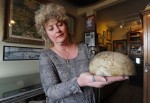 The eggshell skull rule is an old standard of English common law that holds that someone who broke the law is liable for all the consequences of that act, even if they’re unpredictable. So if you hit someone on the head who you don’t know has a skull as fragile as an eggshell and he dies, you’re responsible for his death even if you didn’t know of his condition and had no intent to kill him or even harm him.
The eggshell skull rule is an old standard of English common law that holds that someone who broke the law is liable for all the consequences of that act, even if they’re unpredictable. So if you hit someone on the head who you don’t know has a skull as fragile as an eggshell and he dies, you’re responsible for his death even if you didn’t know of his condition and had no intent to kill him or even harm him.
This rule has been consistently upheld in many a court case and is taught in law school, but I came across a skull today that figured in a case that went the other way entirely.
On Christmas night 1901, gold miner James Roberts had a few drinks at the Dawson Club in what was then a notoriously rowdy part of Colorado Springs. He got into an argument with William Brooks, the bar owner, and when Roberts turned away Brooks took a Colt .45 revolver to the back of his skull. Roberts fell, hitting his head on the stove and then again on the floor.
The evening’s revelers continued to revel around Roberts’ prone body for an hour or so until someone finally thought to call the doctor. It was too late. Roberts had died.
 You would have thought it was an open and shut case, but Brooks bought him some quality justice in the person of J. Maurice Finn, defense attorney to wealthy scalawags the county over, known as the “Oratorical Whirlwind of the West.”
You would have thought it was an open and shut case, but Brooks bought him some quality justice in the person of J. Maurice Finn, defense attorney to wealthy scalawags the county over, known as the “Oratorical Whirlwind of the West.”
Finn put on a novel defense: that Roberts had a particularly thin skull, therefore Brooks couldn’t have known that 2+ pounds of steel wielded with pistol-whipping force would be the death of him. Finn persuaded the coroner to saw off the top part of Roberts’ skull to use it as evidence of his theory in court.
His flair for drama worked and Brooks was acquitted. Roberts’ body was buried in an unmarked grave somewhere in Mount Pisgah cemetery, but the top of his skull stayed in the Teller County Courthouse unnoticed for decades.
In 1974 or 1975, former county attorney P.J. Anderson found the skull next to a bag of gold dust. It made the press, mainly because of the gold, but when the gold turned out be worth less than 20 bucks, interest in the skull faded too. A bar named after Finn wanted the skull to toast to, and a judge wanted to use it as an ashtray, but it stayed in storage in the courthouse for a few decades more.
Then came 2009 and Craigslist.
“I had this flat screen TV my wife said I needed to sell,” Anderson said.
He put it on Craigslist and a Teller County Courthouse employee bought it. During the TV transaction, Anderson told the story of James Roberts and his fractured skull.
“I’ve been telling the story for 35 years,” Anderson said.
The employee went in to work and repeated the story of the TV and the skull. Lisa Wheatcraft, a court reporter, knew of the skull and went to look for it and discovered it was gone.
Wheatcraft tracked down the skull to a former courthouse worker who’d taken it home — and who willingly returned it.
Wheatcraft locked the skull in a drawer and after a few months of digging, offered the skull to the [Cripple Creek District Museum]. [Director Jan] Collins took it and went to work confirming Anderson’s history.
Now the skull is on respectful display. Museum workers greet it every morning when they get there and say goodnight when they leave.
No word on whether it’s actually unusually thin, but it looks normal to me.